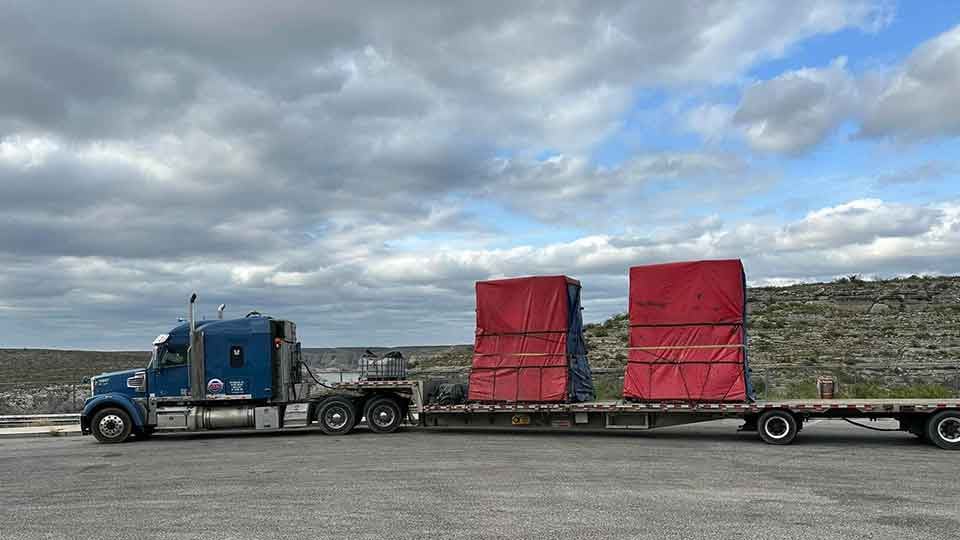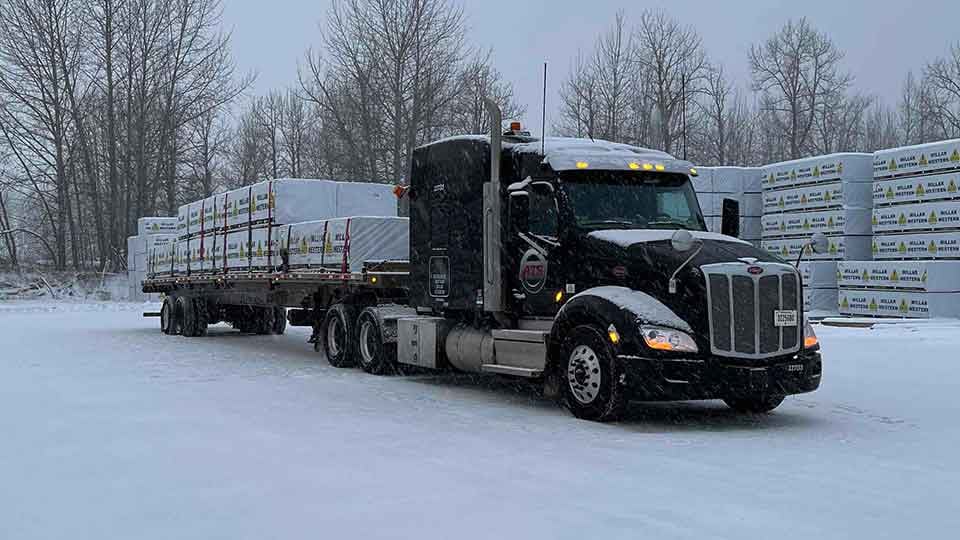
Tarping is the practice of covering open-deck freight with a plastic or canvas tarp. Drivers drape and secure the tarps to protect the cargo from precipitation and road debris.
While it’s a common task for open-deck truck drivers, tarping is an additional service and will be charged separately (plan to pay at least $100).
In the winter, drivers still tarp freight as needed — but the weather makes it a more difficult, and even dangerous, job.
Tarping is always offered for open-deck freight at Anderson Trucking Service (ATS). Our goal is to help shippers understand their options when requesting transportation services.
In the five minutes it takes to read this article, you will learn:
- Why wintertime tarping is more difficult and dangerous
- How shippers can make tarping easier for the driver
- Other ways to protect your freight
- Information to share with your carrier before they pick up the load
The goal is that this article will help you make the best decision for protecting your freight as well as the driver.
Dangers of Tarping Freight in the Winter
Tarps are large sheets of canvas or plastic, usually 6- or 8-feet square. Drivers throw them up and over freight and attach them to the bed of the semi-trailer with bungee cords.
Winter weather makes dealing with tarps uncomfortable and even dangerous.
- Holding a six-foot (or larger) tarp essentially creates a sail, and a strong gust of wind can cause a grown adult to be knocked off their feet.
- Icy build-up on the lot or bed of the trailer means the driver is working on a slippery surface.
- Cold stiffens plastic tarp, making it more difficult to grip, and wearing layers to combat the cold makes it harder to maneuver.
- Rain, snow or sleet makes all surfaces wet, heavy and potentially slippery.
- Shorter daylight hours mean it’s more likely the driver is working in the dark.
Any of these conditions can cause problems with tarping open-deck freight. But most days have a combination of these conditions (for example, icy days are usually cold), making things downright treacherous.
The driver is the one responsible for securing the load as well as the tarp. While the driver is the one who controls the process, shippers can assist.
How Shippers Can Help with Tarping Freight
When your freight needs to be tarped, you can make your load more appealing and safer by taking a few simple steps. While you won’t avoid the tarping charge, helping the driver reduces the risk of accidents and makes this and future loads more appealing.
Place tarps with heavy equipment
If available, using a forklift or crane to move the tarp over the freight saves significant work for the driver. The driver will do the securement, but helping them drape it over the top means they spend less time outside, moving around on the truck bed and battling the elements.
Provide a tarp shed
Some frequent shippers have an onsite shed that they allow drivers to use while covering freight. Even an unheated shed keeps drivers dry and out of the wind.
Other amenities sometimes provided in tarp sheds to assist drivers include lighting and a safety harness — and perhaps a bathroom, an amenity that drivers always appreciate when they are on the road.
Keep your yard clean
Regularly clearing away snow and ice, as well as other debris, keeps it safe for a driver to move around without worrying about slipping and falling. Slick ground can result in a fall within just a few seconds, and slip-and-fall accidents can cause major injuries.
While the driver isn’t an employee of your company, accident prevention benefits everyone. A clean yard protects your employees and visitors, and preventing potential accidents keeps your reputation stellar.
Allow extra time
All the dangers of tarping are magnified if the driver is rushing. If possible, allow the driver an area away from the loading dock where they can cover their load before leaving your property.
Rushing around and crawling over the freight and trailer can help the driver stay safe. Giving the driver a little more time on site means that they can take breaks when they need to, warming up inside the shed.
These options improve the tarping process. Choosing an alternative way to protect your freight is another way to improve driver safety onsite.

Alternatives to Freight Tarping
Tarping open-deck freight keeps it protected from the elements — especially in the winter, when road salt, dirty snow and other debris on the road is more likely to cause problems such as freight damage or arriving dirty.
However, tarping isn’t the only way to protect freight. Depending on the situation, you may have other options.
Use a dry van or Conestoga
Some freight may be better hauled in a Conestoga or dry van. These keep the freight fully enclosed and out of the elements. There is no need to use tarps, and securement takes place inside the vehicle, keeping the driver safe and protected.
Of course, some freight can’t be hauled in an enclosed vehicle. This option is only available for dimensional freight (although a step-deck Conestoga may be available for overheight freight). Dry vans especially must be rear-loaded instead of with a crane or via a side-loading method.
Have the driver wash the freight
If the main concern is that freight can’t arrive dirty, there may be an option for the driver to clean the freight at or near its final location (this is especially likely if the freight travels from a cold to a warm destination, where car washes are open).
Shrink wrap your freight
Some shippers choose to shrink-wrap their freight before it is picked up instead of having it tarped. Shrink-wrapped freight is completely enclosed, with no flaps or loose areas (like there are in tarped freight). The tight wrapping also eliminates friction, which can damage some sensitive cargo.
While shrink wrapping comes with an additional cost to the shipper, frequent winter shippers might find it worthwhile to invest in tarping equipment rather than paying to tarp each load.
There’s more than one way to keep your cargo safe. While tarping is an important tool in the driver’s arsenal, it’s not the only option. Understanding and considering options, and considering alternatives presented by your carrier or broker, may ultimately benefit your shipment as well as the driver.
Variables to Consider Before Specifying a Tarped Load
If your winter shipments require tarping, it’s important to make sure the driver and carrier both know what they are getting into before arriving on site. When specifying your load, make sure to include the following information.
Dimensions and piece count
Your freight carrier always needs to know the dimensions of your freight (including any extensions like booms or augers) as well as the piece count. They will use this data to determine the size and number of tarps needed.
Dimensions and piece count are also needed by the transportation provider to determine if a dry van trailer or alternatives will work.
The need for tarping
Let your transportation provider know that your freight requires tarping. If this isn’t included in the load details, your driver may not have tarps available — which often means you will be charged accessorial fees like truck ordered not used (TONU).
Delicate areas
Some freight can be damaged by the tarp itself or potential friction during transit, such as corners or paint. If your freight is especially vulnerable to this type of damage, be sure to convey that to your carrier representative.
Communicating with your provider is always an important part of the transportation process. Tarped loads involve even more consideration and variables.
Work With the Truck Driver When Tarping Freight
No matter what tarping looks like on your site, working with the driver and carrier before, during and after your shipment gives you the greatest chance of a successful one.
When ordering a load of freight that requires tarping, share all relevant information with the carrier representative. When the driver arrives on site, make sure they understand what is necessary, where they should tarp and any special considerations for your cargo (such as areas that need special protection).
You can protect your freight all winter with tarping and thinking through the process. For specific details about your next shipment, contact ATS.




